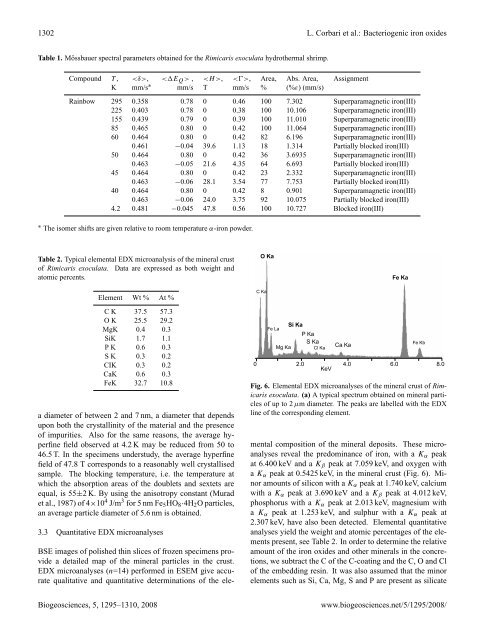View - Biogeosciences
View - Biogeosciences
View - Biogeosciences
Create successful ePaper yourself
Turn your PDF publications into a flip-book with our unique Google optimized e-Paper software.
1302 L. Corbari et al.: Bacteriogenic iron oxides<br />
Table 1. Mössbauer spectral parameters obtained for the Rimicaris exoculata hydrothermal shrimp.<br />
Compound T , , , , , Area, Abs. Area, Assignment<br />
K mm/s ∗ mm/s T mm/s % (%ε) (mm/s)<br />
Rainbow 295 0.358 0.78 0 0.46 100 7.302 Superparamagnetic iron(III)<br />
225 0.403 0.78 0 0.38 100 10.106 Superparamagnetic iron(III)<br />
155 0.439 0.79 0 0.39 100 11.010 Superparamagnetic iron(III)<br />
85 0.465 0.80 0 0.42 100 11.064 Superparamagnetic iron(III)<br />
60 0.464 0.80 0 0.42 82 6.196 Superparamagnetic iron(III)<br />
0.461 −0.04 39.6 1.13 18 1.314 Partially blocked iron(III)<br />
50 0.464 0.80 0 0.42 36 3.6935 Superparamagnetic iron(III)<br />
Corbari et al., Figure 6<br />
0.463 −0.05 21.6 4.35 64 6.693 Partially blocked iron(III)<br />
45 0.464 0.80 0 0.42 23 2.332 Superparamagnetic iron(III)<br />
0.463 −0.06 28.1 3.54 77 7.753 Partially blocked iron(III)<br />
40 0.464 0.80 0 0.42 8 0.901 Superparamagnetic iron(III)<br />
0.463 −0.06 24.0 3.75 92 10.075 Partially blocked iron(III)<br />
4.2 0.481 −0.045 47.8 0.56 100 10.727 Blocked iron(III)<br />
bg-2008-00<br />
∗ The isomer shifts are given relative to room temperature α-iron powder.<br />
Table 2. Typical elemental EDX microanalysis of the mineral crust<br />
of Rimicaris exoculata. Data are expressed as both weight and<br />
atomic percents.<br />
Element Wt % At %<br />
O Ka<br />
C Ka<br />
Fe Ka<br />
C K 37.5 57.3<br />
O K 25.5 29.2<br />
MgK 0.4 0.3<br />
SiK 1.7 1.1<br />
P K 0.6 0.3<br />
S K 0.3 0.2<br />
CIK 0.3 0.2<br />
CaK 0.6 0.3<br />
FeK 32.7 10.8<br />
a diameter of between 2 and 7 nm, a diameter that depends<br />
upon both the crystallinity of the material and the presence<br />
of impurities. Also for the same reasons, the average hyperfine<br />
field observed at 4.2 K may be reduced from 50 to<br />
46.5 T. In the specimens understudy, the average hyperfine<br />
field of 47.8 T corresponds to a reasonably well crystallised<br />
sample. The blocking temperature, i.e. the temperature at<br />
which the absorption areas of the doublets and sextets are<br />
equal, is 55±2 K. By using the anisotropy constant (Murad<br />
et al., 1987) of 4×10 4 J/m 3 for 5 nm Fe 5 HO 8·4H 2 O particles,<br />
an average particle diameter of 5.6 nm is obtained.<br />
3.3 Quantitative EDX microanalyses<br />
BSE images of polished thin slices of frozen specimens provide<br />
a detailed map of the mineral particles in the crust.<br />
EDX microanalyses (n=14) performed in ESEM give accurate<br />
qualitative and quantitative determinations of the ele-<br />
0<br />
Si Ka<br />
Fe La<br />
P Ka<br />
S Ka<br />
Mg Ka Cl Ka<br />
Ca Ka<br />
2.0 4.0 6.0<br />
KeV<br />
Fe Kb<br />
Fig. 6. Elemental EDX microanalyses of the mineral crust of Rimicaris<br />
exoculata. (a) A typical spectrum obtained on mineral particles<br />
of up to 2 µm diameter. The peaks are labelled with the EDX<br />
line of the corresponding element.<br />
mental composition of the mineral deposits. These microanalyses<br />
reveal the predominance of iron, with a K α peak<br />
at 6.400 keV and a K β peak at 7.059 keV, and oxygen with<br />
a K α peak at 0.5425 keV, in the mineral crust (Fig. 6). Minor<br />
amounts of silicon with a K α peak at 1.740 keV, calcium<br />
with a K α peak at 3.690 keV and a K β peak at 4.012 keV,<br />
phosphorus with a K α peak at 2.013 keV, magnesium with<br />
a K α peak at 1.253 keV, and sulphur with a K α peak at<br />
2.307 keV, have also been detected. Elemental quantitative<br />
analyses yield the weight and atomic percentages of the elements<br />
present, see Table 2. In order to determine the relative<br />
amount of the iron oxides and other minerals in the concretions,<br />
we subtract the C of the C-coating and the C, O and Cl<br />
of the embedding resin. It was also assumed that the minor<br />
elements such as Si, Ca, Mg, S and P are present as silicate<br />
8.0<br />
<strong>Biogeosciences</strong>, 5, 1295–1310, 2008<br />
www.biogeosciences.net/5/1295/2008/
















